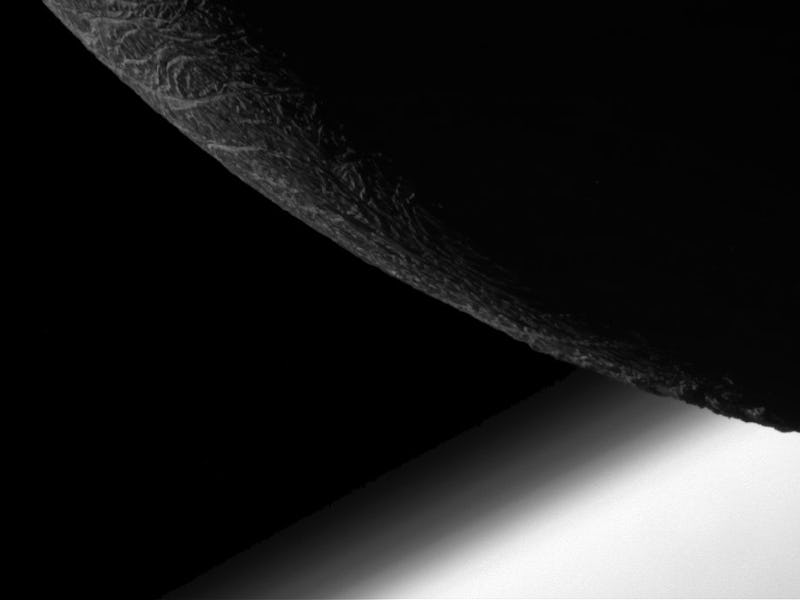A new study improves the odds of Enceladus having alien life
There may be life in Enceladus' deep sea plumes.

From a distance, Saturn’s moon Enceladus is nothing special. The sixth-largest Saturnian moon is an icy world located too far from the Sun, which makes it an unlikely candidate for life.
But after arriving at Saturn in 2004, NASA’s Cassini spacecraft swung past Enceladus at an altitude of 725 miles. That first close flyby revealed an unexpected world with a subsurface ocean and plumes of water ice and vapor erupting from the moon’s south polar region, making it one of the most potentially habitable places of the Solar System.
A new study published in Nature Astronomy further investigates Enceladus’ possible habitability, comparing Earth’s deep-sea plumes, where microbial life thrives, with the ones found on the icy moon, and suggesting that they may be home to Earth-like microorganisms.
Maybe.
Enceladus’ “tiger stripes” showed that the moon is geologically active with a subsurface ocean beneath its icy crust.
What’s new — By looking at data from Cassini, the authors of the paper were able to gather information about the plumes of Enceladus.
These plumes were first identified in 2006, when water was seen shooting from beneath the ice crust of Enceladus hundreds of miles into space at high speeds at the moon’s south pole.
The Cassini spacecraft dove into Enceladus’ plumes several times, conducting mass-spectroscopy measurements of its composition. The plumes were found to contain a relatively high concentration of methane, carbon dioxide, carbon monoxide, and organic materials at much higher rates than expected.
This study honed in on the methane abundance, finding that the environment of Enceladus is ripe for life, and that the methane produced could be biological in origin (or created by a not-yet-understood process). On Earth, methane is mostly produced by microorganisms, while organic compounds are considered the building blocks of life.
But there’s a big difference between having the right stuff for life and life actually kicking off there, according to Marc Rovira-Navarro, a planetary scientist at Delft University of Technology who was not involved in the study.
“Cassini answered quite a lot of interesting questions about Enceladus, but it was not equipped or prepared to do astrobiology research,” Rovira tells Inverse. “So we were super lucky that we could fly through these plumes to get some data out of it, but it didn't have the instruments that you would put in a spacecraft in order to try to detect complex and organic chemistry.”
But the study isn’t directly implying that there is life on Enceladus, but merely that it could provide a habitable environment. If future missions to the moon show no evidence of life, then it would be an example of a habitable environment without actual habitability.
Scientists were shocked to see these images of Enceladus, revealing liquid water on an icy moon located so far away from the Sun.
Here’s the background — Cassini launched on October 15, 1997, and entered Saturn’s orbit on June 30, 2004. The intrepid satellite was originally slated for a four-year mission, which was later extended twice, finally meeting an end in 2017 when it was intentionally crashed into Saturn.
After its first close flyby of Enceladus on February 17, 2005, the spacecraft uncovered interesting geological activity on the icy moon that prompted changes to the mission’s flight plan to increase the number of Enceladus flybys.
During its 20-year mission, the spacecraft conducted nearly 300 orbits of Saturn, and 23 close flybys of Enceladus with multiple deep dives into its plumes.
In 2014, scientists announced that they had strong evidence of a regional subsurface sea on Enceladus, later revising their findings in 2015 to confirm that the moon in fact hosts a global ocean beneath its icy crust.
In order for an environment to be habitable, it mainly needs to have three components, according to Rovira.
- Organic molecules
- Gases such as carbon, oxygen, and nitrogen
- Water
“In the last decades, we have discovered that some of these icy moons of the Solar System have subsurface oceans,” Rovira says. “This has raised many questions about life, and there are even some arguments that would favor these environments rather than Mars.”
An unlikely habitable world, Enceladus has changed scientists’ view of what cosmic bodies could potentially host life.
WHAT’S NEXT — When the Cassini mission first ventured to Enceladus, scientists were not expecting to observe an active ocean world. Scientists are hoping for a future mission to Enceladus carrying instruments capable of probing the chemical compounds of the moon and exploring its ocean.
But some are aiming even higher.
“The ultimate dream for people like me would be to drill through the cracks on Enceladus, and having some kind of submarine hovering around in Enceladus’ ocean and taking all kinds of cool measurements,” Rovira says.
Abstract — Observations from NASA’s Cassini spacecraft established that Saturn’s moon Enceladus has an internal liquid ocean. Analysis of a plume of ocean material ejected into space suggests that alkaline hydrothermal vents are present on Enceladus’s seafloor. On Earth, such deep-sea vents harbour microbial ecosystems rich in methanogenic archaea. Here we use a Bayesian statistical approach to quantify the probability that methanogenesis (biotic methane production) might explain the escape rates of molecular hydrogen and methane in Enceladus’s plume, as measured by Cassini instruments. We find that the observed escape rates (1) cannot be explained solely by the abiotic alteration of the rocky core by serpentinization; (2) are compatible with the hypothesis of habitable conditions for methanogens; and (3) score the highest likelihood under the hypothesis of methanogenesis, assuming that the probability of life emerging is high enough. If the probability of life emerging on Enceladus is low, the Cassini measurements are consistent with habitable yet uninhabited hydrothermal vents and point to unknown sources of methane (for example, primordial methane) awaiting discovery by future missions.